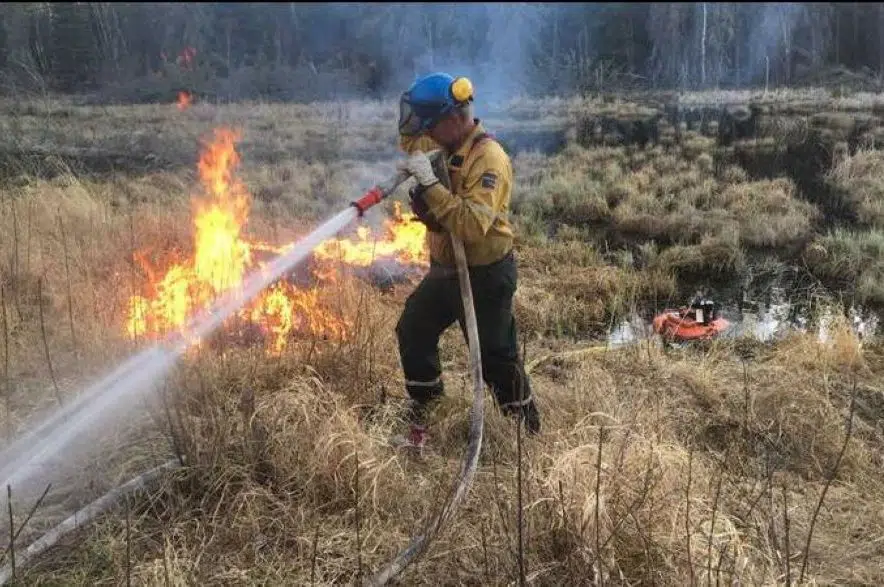By Nigel Maxwell
The Prince Albert Grand Council (PAGC) is renewing its call for the federal and provincial governments to address the escalating wildfire crisis and improve Indigenous firefighting capacity.
This comes amid one of the busiest wildfire seasons in recent years, which has resulted in a number of evacuation orders. Among the areas impacted are Buffalo Narrows, La Loche, Hall Lake and the Clearwater River Dene Nation.
Among its calls for action, the PAGC is advocating for its inclusion in the province’s wildfire management strategies.
“We have been impacted disproportionately by wildfires, and it is critical that we address these challenges proactively. By doing so, we can empower Indigenous communities, protect our lands, and build resilience against future wildfire events,” PAGC Grand Chief Brian Hardlotte said.
“This year’s wildfires in northern Saskatchewan are the worst yet. They’re not just burning hotter, but they’re also burning deeper than ever, reaching all the way down to the ground’s mineral layer. When wildfires consume entire forests, it disrupts the ecological balance, making it difficult for important food sources and medicinal plants to grow back, and this has put our communities in great danger.”
PAGC leadership is insisting on the immediate implementation of the recommendations laid out in the House of Common’s Standing Committee on Indigenous and Northern Affairs “From the Ashes: Reimagining Fire Safety and Emergency Management in Indigenous Communities,” along with those provided in the final report of the 2018 PAGC Wildfire Task Force.
Those recommendations arose from first-hand accounts of First Nation leaders who experienced massive evacuations of their communities, including the Lac La Ronge Indian Band.
Lac La Ronge Indian Band Chief Tammy Cook-Searson presented to the Standing Committee and explained today’s fires are fueled by a shifting climate that burn with intense heat and spread too quickly. She added these are not the cleansing fires of the past that rejuvenated the land and encouraged new growth — these fires are depriving the forest of the opportunity to regrow as it used to.
“This year we have once more felt the impact of wildfires through the extensive evacuations caused by the smoke, which has affected people throughout the province and beyond these borders. Now, more than ever, we need to intensify our efforts to prevent the high costs and emotional tolls associated with these evacuations and health issues,” Cook-Searson said.
Following the largest evacuation ever seen in the province, the PAGC established the Wildfire Task Force in January 2018, comprised of Indigenous leaders and wildfire management experts.
Its year-end report stressed the need for intensified conservation efforts, improved wildfire management, and strong partnerships. It also emphasized the role of climate change in escalating wildfire intensity and the unique challenges faced by vulnerable First Nation communities in northern Saskatchewan.
The report also suggested conducting a comprehensive assessment of damages on First Nations lands for the purpose of mapping out the burn areas for compensation. Sen. Peter Beatty, former chief of the Peter Ballantyne Cree Nation and current member of the Task Force, advocated for the integration of Indigenous perspectives and ancestral knowledge into the wildfire management strategies. He also addressed the Senate Committee in 2017.
“We maintain a profound connection with the land and its resources, which are essential for our survival. And, our rich history in forest fire suppression and our deep connection with the land allow us to provide invaluable insights,” he said.
In addition to financial support, the PAGC is advocating for building capacity in terms of equipment and personnel. The leadership is also urging both levels of government to invest in the training and development of volunteer structural firefighters, offering employment opportunities within Indigenous communities.
By nurturing local talent and expertise, PAGC leaders said the government agencies can reduce reliance on external workforces and contribute to wildfire suppression efforts both within and beyond its territories.
As of Friday, there were 31 active wildfires in the province, and eight were listed as not contained.
To date this year there have been 209 wildfires, which is about 70 more than the five-year average.
Response from government
In a statement, the Saskatchewan Public Safety Agency (SPSA) said it works closely with Indigenous communities, First Nations local leaders, the PAGC Task Force and other governing agencies to support the wildfire response capacity of First Nation communities across Saskatchewan.
“This work has led to changes being implemented, as recommended by the PAGC Task Force,” it said.
The SPSA explained First Nations band councils remain responsible for managing fire protection and emergency response services on reserve.
“The SPSA is aware that some communities, such as small towns and First Nations, have unique needs,” the agency said, adding when an emergency happens, any First Nation community can contact the agency at 1-800-667-9660 to request assistance.
Prior to an emergency, the SPSA noted it works with Indigenous communities to increase their resilience against natural disasters, such as by managing vegetation and wildfire fuel and by improving emergency preparedness plans.
As part of the 2023-24 provincial budget, the SPSA added more Indigenous contract crews to support the wildfire response capacity and to continue protecting Saskatchewan people and creating safe, strong communities.
The SPSA assists First Nation communities and tribal councils year-round in developing the fire services needed for their communities, which includes involving them in initiatives like the recent Transportation Rescue Extrication program.







